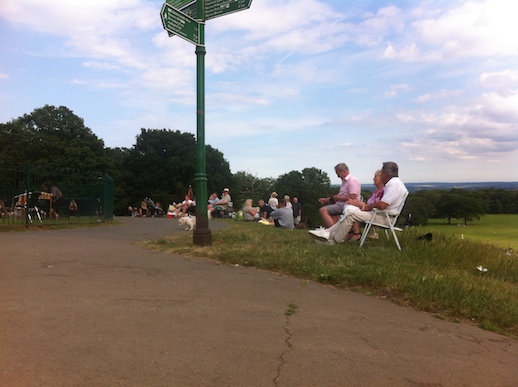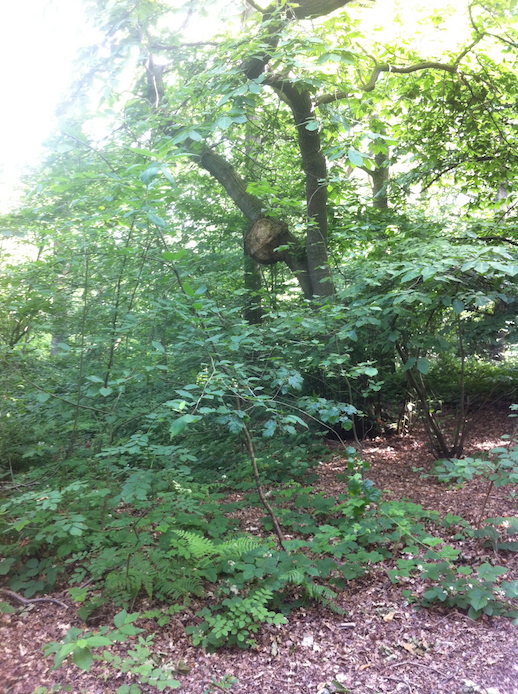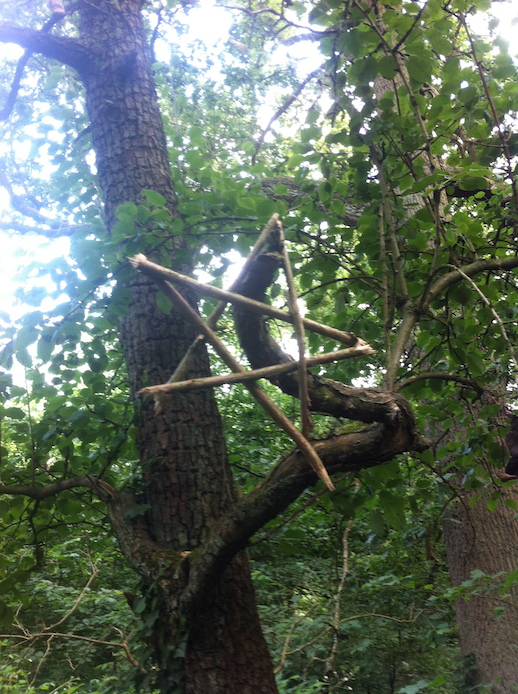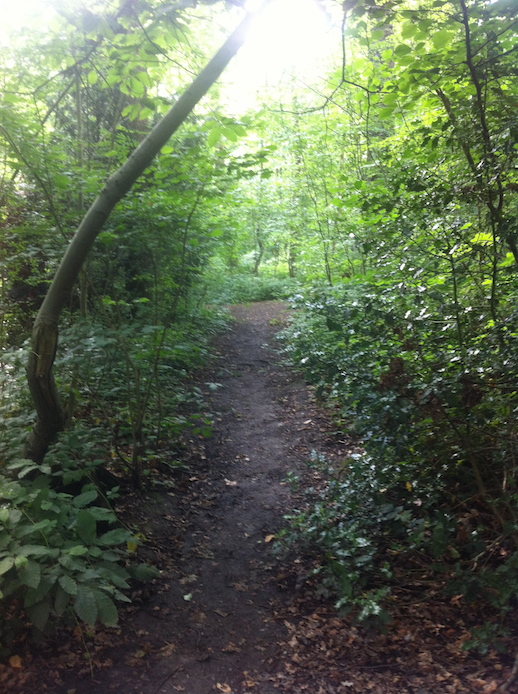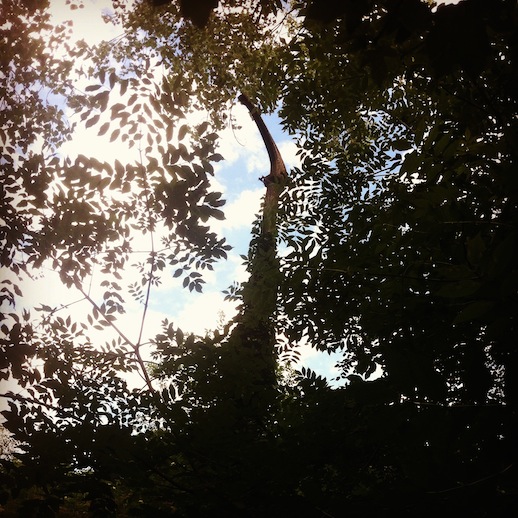Words and pictures: Emma Warren
It’s late on a hot Sunday afternoon. There’s a line of people meandering up the path that connects Oxleas Woods with the rest of the world. Parents are holding hands with children in shorts and pastel baseball caps and it feels like arriving late at the beach, when the first families are shaking off the sand and making their way home for tea. I turn off Kool FM. You get an excellent pirate radio signal up here on Shooters Hill.
Turns out the woods are in holiday mode. I’ve arrived at the tail end of a summer BBQ at the café and families are splashed across Oxleas Meadow picnicking or just watching a band, Fiorenzo’s Strange Brew, who are finishing their first set on the hardstanding outside the 1950s café entrance.
From this point of view, Oxleas Meadow looks like nothing more than the seaside, and the tiny clusters of picnickers have become bathers, dipping up and down on the cool swimming of the grass. The concrete lip of the café and the grassy incline are today beach. A group are playing rounders and a woman in a red dress wallops the air near the ball, drops the bat and performs a You’ve Been Framed stumble-trip towards first base. Someone wallops the ball high into the air to a round of applause.
I’m going into the woods as the band take up their instruments again. They are a grizzled, tight blues rock band, fronted by a fifty-something singer with Keith Richards-style vitality. He has hard-earned biceps, a white vest top and a single dangling earring and he’s playing with a big man bassist in a Hawaiian shirt and Vans. An elderly Alsatian slopes past, panting.
I know where some mature Wild Service Trees are and I know how to get there. I walk along the top path and then downhill to the right. Along, down past bramble hedging to a dirt junction. There are two of them, on either side, grown from subterranean runners not seeds which only survive if the saplings make it to the other side of the path rather than surfacing too soon, like a failed Great Escape.
Strains of Wish You Were Here flow into the cool of the woods. Up above, old ash tops are making a tessellated exit into the sky. You can hardly believe this tree is still standing, what with the huge triangular aperture at the base. There’s a sweet chestnut, just over there, that leans at a comedy 45 degree angle with a big fat burr radiating out on the sloping side. It’s hard to tell how they keep upright, really.
The next song begins, filtered through the branches. The parakeets rise in appreciation and add a polyphonic topline to House Of The Rising Sun. It’s a woodland refix, the creatures that live here adding their own melody and twist to the song.
Deeper into the woods, down the main path. Standing in front of a tree, trying to work out what it is. I’m staring at it for a good ten minutes hoping that the rounded leaves will reveal themselves but nothing happens. The closest I get is buckthorn or a juvenile eucalyptus but none of them quite fit. Then something catches my eye. Someone has made a pentacle out of twigs and hung it on the end of a branch like a witchy Christmas decoration.
Back home, it proves surprisingly hard to find out why someone might put a wooden pentacle on a tree so I end up googling ‘Pagans south east London’ and emailing someone called Luthaneal. He replies a few days later. “To be honest,” he writes, “it could be almost anything. It could be someone engaging in a Pagan ritual or magical working, or it could be someone feeling a bit arty whilst on a stroll.” He concludes that the pentacle is most likely to work of a lone witch, just engaging in a small religious observance, before pointing out that Paganism is the seventh largest religion in the UK with numbers comparable to that of Sikhism. He isn’t aware, however, of any Pagan groups that use Oxleas for their religious practice. I don’t know whether to feel relieved or disappointed.
Last month I’d tried to visit Clothworker’s Woods, a small patch of ancient woods on the other side of Shooter’s Hill Road, that would once have been attached to Oxleas. It’s attached to Woodlands Farm, a warm and welcoming place that runs mini-beast walks for local primary school kids and sells their honey to grateful hay fever sufferers. They’ve got a couple of fields that are in Natural England’s High Level Stewardship Scheme, which means that Woodlands don’t cut the hay until after the middle of July in order to safeguard the flowers and the invertebrates and butterflies that thrive on the ground. They’ve even had sightings of the elusive Purple Emperor butterfly this summer.
Hannah Forshaw is the smiley education officer who also co-ordinates regular citizen science surveys on the farm and in the woods. She pulls out a scrap of paper covered in biro marks and tells me the story of this arboreal survivor.
It goes like this: There was a Clothworker’s Company Guild in the City of London. They were Puritans and they were doing very well until the restoration of King Charles II, who wasn’t into Puritans. They moved to America, buying up areas of land so they’d have somewhere to move back to if life in the New World went as wrong as it had in the old. They set up in Philadelphia, thrived and eventually decided they didn’t need these pockets of land in England. It passed through owners until it ended up with The Co-Op, who now lease it to The Woodlands Trust.
Clothworkers is a secret garden of a place. There are elegant feral plum trees lining the walkways like wedding arches. The fruits are small and yellow and abundant. There’s a huge Silver Birch, that’s over three stories tall with aged, corky bark that suggests it’s older than the usual nine decades these trees make and even more Wild Service Trees. There are no dogs, no walkers, just us.
We walk back, down a concrete path which is being absorbed into the woods. There are lampposts like leaning pteradactyls, covered in ivy, dissolving and disappearing back into nature.
This is all under threat again. In 1993, local people power (and perhaps some Pagan assistance) averted a three lane road from destroying both Clothworker’s and Woodlands Farm as well as a sizeable chunk of Oxleas.
This month Boris announced his support for the 2014 iteration, Gallions Bridge.
I contact The Woodland Trust and Richard Barnes, their Senior Conservation Advisor gets back in touch, quickly. “Even though Oxleas is a Site Of Scientific Special Interest (SSSI), “ he says, “the potential threat of a motorway ploughing through it continue to loom over it.” A local blogger and Oxleas expert tells me that huge congestion in residential roads will lead to pressure to link to the A2, right through Oxleas and through Clothworker’s Woods and points me towards the new @NoToGallions twitter feed.
I email the London Chamber Of Commerce asking what their bridge means for Oxleas, but they don’t reply. Let’s hope we don’t have to ask the Pagans back.
